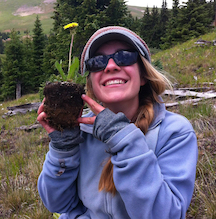Teachable Moments Series

Zombie ants, tapeworms, fungi & feces!
“You can talk about sex, or you can gross ’em out.” This is author and educator Dr. Jon Herron’s sure-fire strategy for making his audience sit up and take notice, and one he wrote about in a post for SimBio 15 years ago this month! And while none of the many examples I’ve turned to during the intervening years packs quite the same punch as a canine transmissible venereal tumor, I do love that I’ve been able to present myself as a decaying corpse to my students (yes, I was the model for one of the decomposing cadavers in the simulated body farm found in Decomposition).
Unsurprisingly, I’ve been thinking about rotting corpses, decomposition, and—of course—zombies of late. After all, October’s the time of year when leaves turn splendid colors, fall, and rot and when all things gross start popping up as my neighbors decorate their yards for Halloween. And, yes, folks in Missoula pull out all the stops for this most ecological of holidays. But my mind is less on Jack-o’-lanterns then on the leaves in my yard and why it might be good to leave them where they fall.
As the Washington Post recently wrote, fallen leaves provide an ecological bonanza of sorts. It’s a good article and one that offers a wonderful (if not particularly creepy) way to begin discussions with students about decomposition and the roles played by the various creepy crawlies that help break them down. Of course, if I want to capture their attention, I focus on the importance of fungi and feces in decomposition. Stream ecologists will recognize that many of the invertebrates feeding on decomposing leaves gain more from the biofilm of fungi and bacteria breaking them down than from the leaves themselves. Or, as Kenneth Cummins put it: leaves are the comparatively worthless crackers and the biofilm is the energy-rich peanut butter sustaining decomposers. Of course, the mayflies, caddisflies, and other “scrapers” feeding on this peanut butter are a small portion of the decomposer community found in streams. Collectors—particularly, the filter feeders—are critically important for breaking down particles suspended in the water column. And what do nymphs like the net-spinning caddisflies seine from the current? Feces! That’s right, the fecal matter of larger invertebrates is a primary food source for many filter feeders! The role of feces as a food source isn’t quite as gross as the use of invertebrate succession to age a submerged corpse, but it is in keeping with the Halloween spirit.
Of course, nothing says Halloween like zombies and two of the best zombie stories are real. First consider the lancet fluke, which has a wonderfully complex and delightfully gross life cycle. Adults most commonly infect the bile ducts of herbivorous mammals including sheep and cattle. Their eggs are expelled with the host’s feces and are ingested by terrestrial snails (feces as food, again!). Cercaria—the larval stage of the fluke—are egested from the snail in slime balls, which are collected and eaten by ants. Now, here’s where things get weird. The larva mature into metacercariae and migrate to the ant’s brain, attach to nerve cells, and begin to alter the ants behavior. The fluke compels the ant to climb up blades of grass and firmly clasp the tip, where they are more likely to be accidentally ingested by grazing mammals. Once the ant is eaten, the flatworm migrates the herbivore’s bile duct where it matures and produces its eggs, beginning the cycle anew.
As compelling as zombie ants are—and the warped world of zombie ants has inspired a whole subgenre of apocalyptic fiction including The Girl with All The Gifts and The Last of Us—zombie ants are not my favorite real-life story of the undead. No, that would be the life cycle of Schistocephalus solidus, a tapeworm that puts a whole new twist on schooling fish.
S. solidus are found in the gut of kingfisher and other fish-eating birds, where they reproduce but don’t grow. Their eggs are shed in the bird’s feces. Some of these eggs—the lucky ones—are dropped in stream or lake where they hatch. The resulting larvae infect copepods, small crustaceans that are consumed by three-spined stickleback fish. Once in the fish, the tapeworm grows and grows—occasionally reaching a mass equal to the fish that ate it! As with the zombie ants, the parasites alter the behavior of their intermediate hosts. Infected fish are slower and less mobile than healthy fish. What’s more they tend to engage in more risky behavior and thus are more likely to caught by piscivorous birds, enabling the parasite to complete its life cycle.
Perversely, the altered behavior of the infected fish is bad news for healthy fish, too. This is because sticklebacks are a schooling species, and healthy fish tend to follow the lead of their infected chums. As a result, healthy fish also spend more time in high-danger areas, even when potential predators have been active.
For me, these examples a great way to tie together concepts introduced in our chapters on Life History, Behavioral Ecology, and Predation, Parasitism, and Herbivory. More importantly, by choosing stories with a healthy gross-out factor, I ensure that my students will remember the examples, and, with luck, the underlying lessons about complex life histories, predation risk, and zombies.
Happy Halloween!







 Highlights from SABER
Highlights from SABER
